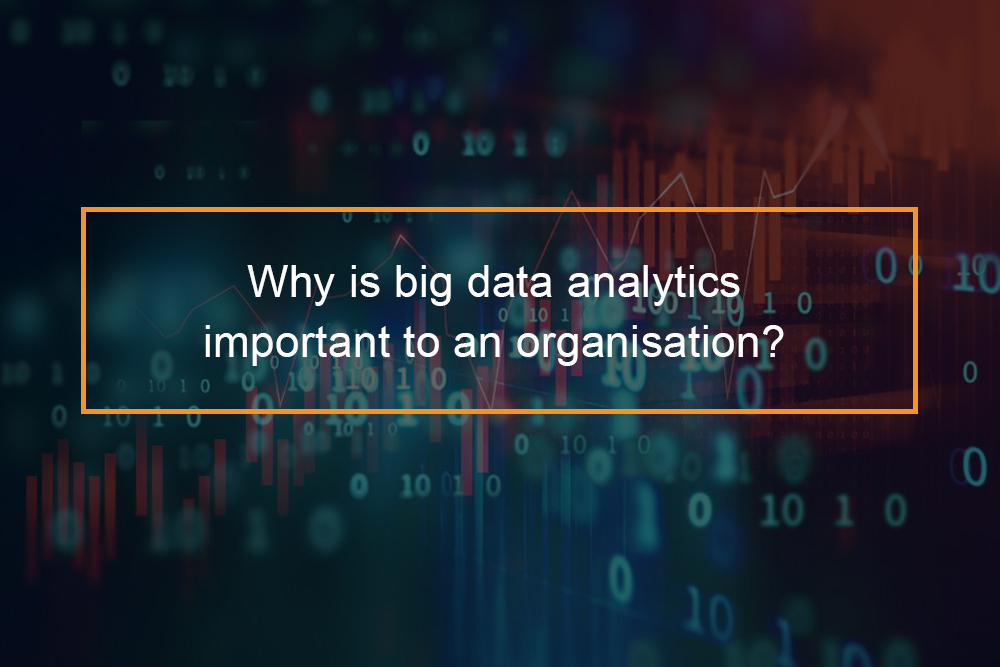
With today’s technology , it is possible to examine large amounts of data and uncover hidden patterns,correlations and other insights. Big data analytics, will help you examine big amounts of data and even get answers from it almost immediately-it is more efficient compared to traditional business intelligence solutions.
This post will help you understand how to capture all the data that streams into your organization, so that you can apply analytics and get significant value from it.
What is the use of big data analytics?
Big data and business
First thing first, it is important to understand the emergence of big data and how it came to be utilized in businesses.
Emergence and growth of big data analysis in an organization
Big data which was a term used to refer to increasing data volumes in the 1990s, today expands the notion of big data to also include increases in the variety of data being generated by organizations and the velocity at which that data is being created and updated.
With time the three factors- volume, velocity and variety, became the popularized concept known as the 3Vs of big data.
In 2006, the Hadoop distributed processing framework was launched separately as an Apache open source project. The framework was geared to run big data applications. By 2011,big data analytics along with Hadoop began to take a firm hold in businesses and the public and various related big data technologies that had sprung up around it.
Basically, as the Hadoop ecosystem started to mature, big data applications were primarily the province of large internet and e-commerce companies such as Yahoo, Google and Facebook. This included analytics and marketing services providers.
Over years big data analytics has increasingly embraced retailers, financial services firms, insurers, healthcare businesses, manufacturers, energy companies and other enterprises.
Big data analytics software
Traditional data warehouses can not handle the set of real time big data from online activities of website visitors or the performance of mobile applications.
Further, the traditional data warehouses can not handle the unstructured and semi structured data types as they do not fit well in the traditional data sets.
Thus, companies have turned to big data technologies which easily handle the processing demands posed by sets of big data. The databases and their companion tools include:
-
YARN big data software
This is one of the features in the second generation Hadoop database which is a cluster management technology.
-
MapReduce data analysis software
This is a tool that enables developers to write programs that process massive amounts of unstructured data in parallel across a distributed cluster of processors or stand-alone computers.
-
Spark big data software in your organization
This open source, parallel processing tool enables users to run large scale data analytics applications across clustered systems.
-
Pig big data software in a business
This is an open source big data technology which offers high-level mechanism for the parallel programming of MapReduce jobs executed on Hadoop clusters.
-
Hive data analysis software
This is an open source data warehouse utilized for querying and analyzing big data sets stored in Hadoop files.
-
HBase big data software
HBase is a column-oriented value data which is store built to run on top of the Hadoop Distributed File System.
-
Kafka data analysis tool in a business
This is big data technology tool specially designed to replace a traditional message brokers. It is also known as a subscribe messaging system.
How big data analytics software works in a business?
Hadoop and NoSQL systems in some cases are used primarily as landing pads and staging areas for big data before it gets loaded into a data warehouse. However, most big data analytics users are adopting the concept of a Hadoop data lake which is used primarily for staging incoming streams of raw data.
In this case, big data can be analyzed directly in a Hadoop cluster or run through a processing engine like Spark. In instances where Hadoop and NoSQL are used primarily as landing areas for data is loaded in a summarized form which is more conducive to relational structures.
Data which is stored in the Hadoop distributed file system must be organized, configured and partitioned properly as in data warehousing, sound data management is a crucial initial step in the big data analytics process. This ensures there is good performance out of both extract, transform and load integration jobs and analytical queries.
A software commonly used for advanced analytics processes analyzes the data once it is ready-this includes tools for data mining, which sift through data sets in search of patterns and relationships; predictive analytics, which build models to forecast customer behavior and other future developments.
It also comprises of machine learning which is responsible of tapping algorithms to analyze large data sets; and deep learning which is a more advanced offshoot of machine learning. Text mining, statistical analysis, mainstream BI software and data visualization tools play a role in the big data analytics process.
Questions can be written in MapReduce for both ETL and analytics applications. The programmes which can be used in writing questions include:
- R big data software
- Python
- SQL
- Standard languages for relational databases that are supported via SQL-on-Hadoop tools.
Unstructured data types include:
- Text files and documents
- Video files
- Emails
- Images
- Audio files
- Text files and documents
- Sensor data
- Server, website and application logs
Big data analytics uses and challenges
No tools comes without challenges. Big data analytics applications often include data from both internal systems and external sources, such as weather data or demographic data on consumers compiled by third-party information services providers.
Early, big data technologies were mostly utilized in big companies that collected, organized and analyzed massive amounts of data. However, cloud platform vendors, such as Amazon and Microsoft have made it easier to setup and manage Hadoop clusters in the cloud.
Potential challenges which could come with big data technology include lack of internal analytics skills. Not to mention high costs of hiring experienced data scientists and data engineers to fill the gaps.
However, to curb this challenge recently, there have been proliferation and advancement of AI and machine learning technologies which has powered vendors to produce software for big data analysis which is easier to use.
The leading vendors include:
- Alteryx
- IBM
- Microsoft
- Knime
But the amount of data which is managed can cause data management issues in data quality, consistency and governance.
Even worse data silos can occur as a result of use of different platforms and data stores in a big data architecture.
Moreover, integrating Hadoop, Spark and other big data tools into a cohesive architecture that meets a business large data analytics requires is a challenging proposition for many IT and analytics teams as they have to identify the right mix of technologies and then put the pieces together.
Why is big data analytics so important?
Importance of big data analytics in business
In digital transformation journey, big data and analytics plays a major role in a business success.
Big data can be equated to better business
Basically, data has evolved gradually in type, volume and velocity globally. And has become the new business currency. The growth of data will be the key to the transformation and growth of enterprises over the world.
Big data therefore is very beneficial to a business. Understanding the importance of big data is therefore a key to the successful implementation of operational strategies which facilitate agile and effective business growth.
-
Use of big data analysis can better your business in the following areas
Big data will enable your business future strategies and immediate changes. The following values will better your business.
Big data analytics means faster and better decision making for an organization
Correct harness of data will help you gain better, fact based decision making. This will help to the overall customer experience. By using big data technologies such as Hadoop and in memory analytics, combined with the ability to analyze new sources of data, organizations can analyze information immediately-thus the decisions made are based on what they have learned.
With big data analysis you will have quick reactions to business challenges
Use of big data technologies enables organisations to answer queries quickly compared to traditional business intelligence methods. In fact with big data you can answer questions in days or seconds. Therefore a business can respond to challenges facing the business quickly. This acceleration is of great advantage to your business as you will improve overall business performance, provide answers for complex problems that could have otherwise resisted analysis.
Use of big data software strengthens relationships among departments
For big data and analytics there is need for various departments to work together so as to successfully deliver the promised results of big data. Data management in big data helps to break down organisational boundaries so as to create better integration between the IT and business departments.This builds teamwork in a business and improves relationship between employees.
Big data analytics will help you reduce the cost of running your business
Big data technologies are economical when it comes to storing large amounts of data. Technologies such as Hadoop and cloud-based analytics helps users to identify more efficient ways of doing business.
Big data analytics helps an organization discover new products and services Business
Analytics skills, technologies and practices investigate the past business performance to gain insight and drive business planning. You are also able to discover opportunities which the business could have missed. You are also able to evaluate customer needs and satisfaction through analytics and know customers tastes and needs. With this you can create new products and services to meet customers needs. Basically, the key is integrating big data with traditional business analytics to make a data ecosystem that allows the business to generate new insights while executing on what it already knows.
What skills do I need in big data analytics to have a successful business?
As an organization there is a need to consistently develop big data analytics skills so as to be able to determine project success.
Proficiency with data mining and visualisation tools ranks as one of the most important skills in determining project success.
Basically the main trend in big data is machine learning. However, you will need the following predictive analytic apps so that big data experts can harness machine learning technology to build and train.
- Classification big data analytic app
- Recommendation big data analytic apps
- Personalisation systems software
It is also important to accomplish statistical and quantitative analysis, which aims to understand and predict behavior and events through the use of:
- Mathematical measurements and calculations big data techniques
- Statistical modelling big data techniques
- Research big data analysis skills
Other key data mining techniques that are utilized globally
-
Use of association big data skills for your organization
This is one of the most popular data mining techniques. With this technique a pattern is discovered based on a relationship between items in the same transaction.
-
Classification big data skills
This is a data mining technique which is based on machine learning.
-
Clustering big data skills in a business
This is a technique where meaningful or useful cluster of objects which have same characteristics using the automatic technique.
-
Utilization of prediction analysis skills in a business
This is a data mining technique that discovers the relationship between independent variables and the relationship between dependent and independent variables.
-
Sequential patterns big data analysis skills for a business
This data mining technique aims to discover and identify the same patterns, regular events and trends in transaction data over an organization period.
-
Decision tree big data analytic technique in an organization
Basically the decision tree works around simple question or condition that has multiple answers.
Important skills stakeholders in an organization should know in data analysis?
Stakeholders play an important role in the success of a business, therefore it is important to educate them and make sure they are aware of data value. This will play a vital role in business continuity and growth.
It is important to inform them correctly about big data so that they may not find the techniques complex.You can have regular meetings and forums to enforce the importance of big data and the need for it.
The simplicity and cost effective nature which comes with deploying and maintaining big data technologies are core benefits and therefore should be employed as a necessity to improve and enhance business efficiency.









